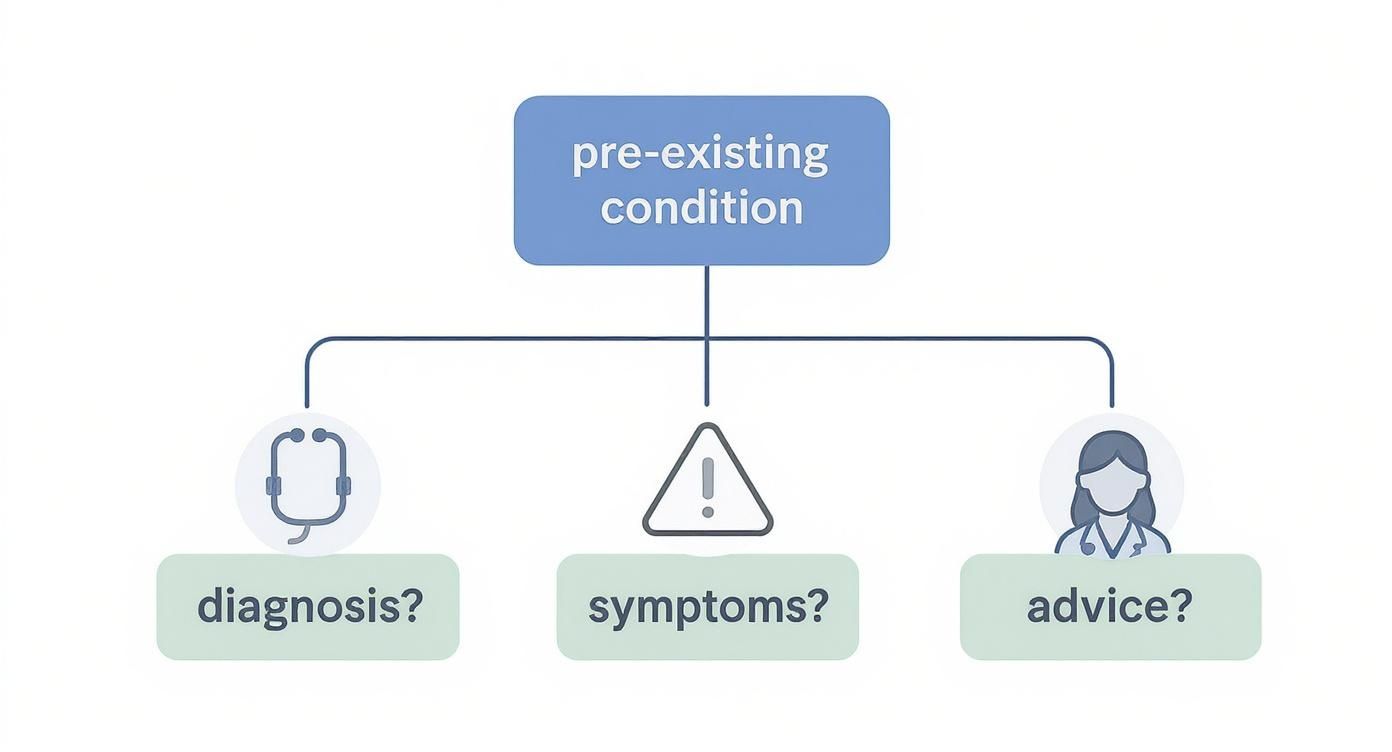A hard truth most global citizens learn is that finding international health insurance with a pre-existing condition can feel like navigating a minefield. However, what the industry doesn't always make clear is that securing coverage is not impossible; it simply requires a refined strategy.
Securing robust insurance for a pre existing condition is entirely achievable. The key isn't if you can get covered, but how you approach the process. It's about understanding the insurer's perspective on risk and presenting your health history in a manner that leads to the most favorable terms.
Navigating Global Health Insurance with a Pre Existing Condition
For anyone accustomed to managing a complex investment portfolio, this process is analogous. It's a strategic exercise in risk management. The international insurance landscape operates on principles quite distinct from domestic markets, which are often heavily shaped by national legislation like the Affordable Care Act (ACA) in the United States.

The Global Perspective on Coverage
Unlike many national health plans, international policies are almost always built on a foundation of individual risk assessment, a process known as medical underwriting. This is the mechanism by which insurers maintain a stable and sustainable pool of members—by carefully evaluating each applicant's unique health profile.
This is a stark contrast to systems reshaped by sweeping government mandates. Before the full implementation of the Affordable Care Act (ACA), for instance, U.S. insurers could routinely deny coverage for conditions like diabetes or heart disease. In fact, a 2011 U.S. government analysis estimated that up to 129 million Americans under 65 had a pre-existing condition that could have led to a denial of coverage in the individual market.
This distinction is crucial for expatriates. Your ability to secure international coverage hinges on presenting a clear, well-documented health history to insurers who specialize in precisely this kind of individual assessment.
A pre-existing condition doesn't automatically disqualify you from premier international health coverage. Instead, it initiates a detailed conversation between you, your advisor, and the insurer to define the precise terms of your global health security.
Strategic Planning for Global Mobility
Securing the right coverage is not a last-minute endeavor. It demands foresight, especially if your life or retirement plans span multiple jurisdictions. The quality and cost of healthcare can vary dramatically from one nation to the next.
Therefore, a proactive approach is non-negotiable. Before evaluating policies, you should be researching the healthcare infrastructure in your potential destinations. This level of preparation ensures your insurance solution doesn't just fulfill a requirement—it genuinely aligns with your health needs and global ambitions, providing true peace of mind.
What Insurers Consider a Pre-Existing Condition
To secure the right international health insurance, one must first adopt an insurer's perspective. What do they truly mean by a "pre-existing condition"? This is not a mere dictionary definition; it is far broader than a formal diagnosis documented in your medical file.
In their lexicon, it encompasses any medical issue—significant or minor—for which you have sought advice, received care, or undergone treatment before your policy's inception date.
Consider this: if a reasonable person would have consulted a physician for the symptoms, an insurer will classify it as pre-existing. This is not a matter of being difficult; it is the fundamental basis of risk assessment. They require a complete health profile to price a policy accurately.
This means well-managed chronic conditions such as hypertension, high cholesterol, or a thyroid imbalance fall squarely into this category. The same applies to historical injuries. A knee injury from a skiing trip five years ago or back pain for which you consulted a physiotherapist? Those are included, as they indicate a potential for future claims.
The Scope of Disclosure
The insurer’s lens is both historical and symptomatic. They are as interested in what you have experienced as what you have been formally diagnosed with. Grasping this distinction is perhaps the most critical component of the application process.
An insurer defines a pre-existing condition as any ailment, illness, injury, or disease that you had signs or symptoms of, or for which you received medical advice, diagnosis, care or treatment, before your policy's start date. Full, honest disclosure is the bedrock of a solid insurance contract.
For instance, recurring migraines, even without a specific diagnosis for the cause, are considered pre-existing if you have consulted a doctor or taken prescription medication for them. A bout of severe back pain a year ago that prompted a visit to a specialist must be declared.
To better understand this in practice, it is helpful to review guides on health insurance for chronic conditions, as these are the issues that receive the most scrutiny.
Common Examples of Pre-Existing Conditions
While every medical history is unique, certain conditions are almost universally flagged as pre-existing by international insurers if they were present before inception. Understanding these helps set realistic expectations from the outset.
Here are some of the primary conditions that always require full disclosure:
- Chronic Illnesses: Conditions such as diabetes, asthma, and chronic obstructive pulmonary disease (COPD) are textbook examples.
- Cardiovascular Issues: Any history of high blood pressure, heart disease, or elevated cholesterol must be declared.
- Mental Health Conditions: Past or current treatment for anxiety, depression, or bipolar disorder is considered pre-existing.
- Musculoskeletal Problems: This encompasses everything from chronic joint pain and arthritis to unresolved issues from past injuries.
- Cancer: Any history of cancer, even if in long-term remission, is a critical element of your medical history for an insurer.
Attempting to conceal any of these can have severe consequences, leading to denied claims or even the cancellation of your entire policy when it is needed most. For a deeper analysis of policy language, consult our guide on how to understand your insurance policy terms. This knowledge equips you with the strategic transparency required for a successful application.
How Underwriting Determines Your Coverage Options
Underwriting is the insurer's due diligence on your health profile. It is the process they employ to quantify their risk before offering you a policy. For an expatriate with a pre-existing health condition, this is not merely a procedural step—it is the single most important phase of the application.
The outcome of this "health audit" dictates everything: what is covered, what is excluded, and the final premium. It is about establishing a fair contract and avoiding unforeseen liabilities. Each underwriting approach balances upfront disclosure, speed, and certainty differently, making your choice critical.
This chart breaks down what insurers are really looking for when they talk about a "pre-existing condition." It’s not just about a formal diagnosis.

The key takeaway? An insurer's definition is broad. It includes any symptoms you’ve felt or advice you've sought, even if you never got a specific diagnosis.
Full Medical Underwriting (FMU)
Full Medical Underwriting (FMU) is the comprehensive disclosure approach. You will complete a detailed health questionnaire, outlining your entire medical history. The insurer may subsequently request reports from your physicians to gain a complete understanding.
The significant advantage here is certainty from day one. Before you remit a single premium, you know precisely what is covered, what is excluded, and what may incur an additional cost (a "premium loading"). For a well-managed chronic condition, an insurer might offer full coverage but at a higher premium. For something more recent or complex, they might exclude that specific condition entirely.
FMU is the preferred path for individuals who require absolute clarity. It eliminates guesswork, allowing you to plan your global healthcare with a precise understanding of your policy's parameters.
While it demands more effort upfront and can take several weeks, this investment of time yields a solid, predictable agreement. There is no ambiguity when a claim arises.
Moratorium Underwriting
Moratorium Underwriting is fundamentally different—it operates on a "wait-and-see" basis. You are not required to disclose your medical history upon application. Instead, the policy automatically excludes any condition for which you have had symptoms, advice, or treatment in a set period, typically the five years preceding your policy's start date.
Coverage for these conditions may become available later. You typically must complete a continuous "moratorium period" of 24 months after your policy starts without any symptoms, treatment, or advice for that specific condition. If this is achieved, the condition may become eligible for coverage.
This approach is faster to arrange but is fraught with uncertainty. You will not know if a condition is covered until you file a claim, which triggers an investigation into your medical history. A moratorium may be suitable for minor, historical issues, but it represents a significant risk for any major or chronic condition where reliable access to care is paramount.
As a general rule, most international insurers will automatically exclude any medical issue you experienced in the five years before your policy began, diagnosed or not. Some plans, typically those with moratorium underwriting, might cover these conditions after a symptom-free waiting period of two years. You can find more details about how international insurers handle pre-existing conditions on internationalinsurance.com.
To help you decide which path is right for you, here’s a quick comparison of the two main underwriting models.
Comparison of Underwriting Models
This table compares the key features of Full Medical Underwriting and Moratorium Underwriting to help applicants choose the best approach for their needs.
| Feature | Full Medical Underwriting (FMU) | Moratorium Underwriting |
|---|---|---|
| Disclosure | Full medical history declared upfront on an application form. | No initial medical declaration required. |
| Certainty | High. You know what is covered or excluded from day one. | Low. Coverage for pre-existing conditions is uncertain. |
| Application Speed | Slower. Can take several weeks due to medical review. | Faster. Policy can be issued very quickly. |
| Claims Process | Simpler. Coverage decisions are already made. | More complex. Insurer investigates medical history at claim time. |
| Best For | Individuals who want absolute clarity and have ongoing conditions. | Individuals with minor, historical conditions or who need coverage fast. |
Ultimately, the choice between FMU and Moratorium depends on your personal risk tolerance and health history. FMU offers peace of mind through transparency, while a Moratorium offers speed at the cost of certainty.
Continued Personal Medical Exclusions (CPME)
Continued Personal Medical Exclusions (CPME) is a highly specialized option. It is designed for a specific scenario: when you are transitioning from a company group health plan to an individual policy with the same insurer. This is ideal for an executive leaving a corporate role who wishes to maintain their premier health coverage.
With CPME, the insurer essentially agrees to carry over the terms from your previous group plan. This means you do not undergo a new medical assessment, and any conditions that developed while you were on the group plan are grandfathered in.
The benefits of CPME are substantial:
- Guaranteed acceptance: You can switch to an individual plan without a new application.
- Continuity of care: Conditions covered under the group plan remain covered.
- No new exclusions: The insurer cannot add new restrictions for health issues that arose during your employment.
This option creates a seamless bridge, ensuring your health security is not disrupted by a career transition. It is a vital tool for maintaining quality coverage between professional engagements.
Understanding Underwriting Outcomes: Loadings and Exclusions
Once an underwriter has reviewed your medical history, their decision is not a simple "yes" or "no." It is a carefully calibrated offer that establishes the terms of your entire insurance contract. Understanding this offer is absolutely critical before you commit.
For anyone with a pre-existing condition, the decision typically results in one of two outcomes: a premium loading or a policy exclusion. These are two very different methods for an insurer to manage the risk presented by your health profile.
Decoding Premium Loadings
A premium loading is, in essence, an increase to your standard premium. It is the insurer's way of stating, "We recognize your condition carries a higher statistical risk of claims. We will agree to cover it fully, but at an additional cost."
This is often the optimal scenario for conditions that are stable and well-managed. For example, if your hypertension is controlled with medication, an insurer might apply a 25% or 50% loading to your premium. While your regular payment is higher, you gain the assurance that any care related to that condition is fully covered.
A loading indicates the insurer is comfortable accepting the risk, provided they are compensated for it. It is a financial agreement where risk is shared, with the price adjusted to match your specific health profile.
The Impact of Policy Exclusions
An exclusion is a much more definitive measure. This is a formal clause in your policy stating the insurer will not pay for anything related to a specific medical condition—not symptoms, treatments, nor complications.
This is a common outcome for conditions that are more volatile, have been recently diagnosed, or have a history of costly treatments. If you have recently undergone complex spinal surgery, for example, the insurer will almost certainly apply an exclusion to anything related to your back. Any future consultations, physical therapy, or follow-up procedures for that issue will be your financial responsibility.
An exclusion surgically removes a specific risk from the policy, placing the entire financial burden for that condition squarely on your shoulders. A loading, in contrast, distributes the risk through higher premium payments while keeping your coverage intact.
It is imperative to read the fine print. To better understand how these clauses are worded and their implications, review our detailed guide on what to watch out for with policy exclusions. This is not merely helpful advice; it is essential reading for any individual with a medical history.
The Role of Waiting Periods
A third, less frequent outcome is a waiting period. This is a specified duration after your policy begins during which you cannot claim for certain types of treatment.
This is most common for benefits such as maternity care. Insurers typically apply a 10-12 month waiting period to prevent individuals from purchasing a policy only when they anticipate needing expensive care. It can also apply to major dental work or certain elective surgeries. During this period, you pay your premiums, but the coverage for that specific benefit has not yet commenced.
Navigating these underwriting decisions is a uniquely global challenge. In the United States, the Affordable Care Act (ACA) largely eliminated denials of coverage for pre-existing conditions. The international private medical insurance market, however, operates under a different set of rules. A 2008 study from the Congressional Budget Office, before the ACA's major reforms, estimated that 4 million Americans might have sought coverage through high-risk pools had they been more robustly funded. While the US system has evolved, most global insurers still rely heavily on this type of medical underwriting. You can get more historical context on covering pre-existing conditions at NationalAffairs.com. This global reality makes understanding loadings and exclusions an absolute necessity for every expatriate.
Alternative Strategies for Securing Health Coverage
Receiving a policy offer laden with exclusions—or an outright denial—may feel like an impasse. It is not. For discerning individuals, it simply signals a shift from a direct application to more creative, structural solutions for securing robust health coverage.
The most potent alternative is often a corporate or group plan. Many international private medical insurance (IPMI) plans offered through an employer completely waive individual medical underwriting. This critical feature, known as Medical History Disregarded (MHD), guarantees acceptance for every member, regardless of their health history.
Leveraging Group and Corporate Plans
For executives, partners, or business owners, structuring your coverage through a small corporate group plan can be a transformative solution. It may be surprising to learn that even a small group of two or three employees can sometimes qualify for MHD terms, instantly resolving the pre-existing condition challenge. This route provides access to comprehensive coverage that would be unattainable on an individual basis.
When an individual application is blocked by underwriting, a group policy often provides an open door. The insurer's risk is spread across the entire group, removing the focus from any single person's health history.
This strategy cleverly aligns your personal health security with your professional or business structure, creating a seamless and powerful solution. It ensures you do not have to compromise on access to world-class healthcare.
Exploring Local and Specialized Plans
Another effective strategy involves a layered approach. Begin by securing a fully compliant local health plan in your country of residence. National or regional insurance markets often operate under different regulations than the global IPMI market, and some are far more accommodating of pre-existing conditions.
This local plan becomes your foundation, covering routine care and managing your known conditions within that country's healthcare system.
From there, you can add specialized plans to address any gaps. These might include:
- Medical Evacuation-Only Plans: These policies serve a single purpose: transporting you to a center of medical excellence in a crisis. They are relatively inexpensive and typically do not involve extensive medical underwriting, providing a crucial safety net for a catastrophic event.
- High-Risk Providers: A select number of insurers specialize in covering individuals with complex health profiles who are declined by standard carriers. The premiums are higher, but they offer a viable path to comprehensive coverage when other options are unavailable.
This multi-layered approach demonstrates that with strategic planning, you can construct a portfolio of protection that secures high-quality healthcare access abroad, even with a complex health profile. By combining different policy types, you can build a bespoke solution that meets your unique needs, restoring your control over your global health arrangements.
Preparing a Successful Insurance Application
Achieving the best terms on your international health coverage depends on a meticulously prepared application. This is not mere paperwork; it is a strategic presentation of your health profile, designed to provide underwriters with a complete and transparent view of your medical history.
This is absolutely crucial when seeking insurance for a pre existing condition. A disorganized or incomplete submission is a fast track to delays, unfavorable terms, or even an outright denial. By anticipating the insurer's requirements, you position yourself for the best possible outcome from the start.

Assembling Your Essential Documentation
The foundation of your application is a comprehensive file of your medical records. Vague summaries are insufficient. Underwriters require specific, detailed evidence to make an informed decision, and your objective is to leave no room for ambiguity.
Your documentation checklist must include:
- Detailed Physician's Letters: Obtain a letter from your specialist that confirms your diagnosis, details your treatment history, and—most importantly—clearly states that your condition is currently stable.
- Complete Diagnostic Reports: Gather copies of every relevant lab result, MRI, CT scan, and any other diagnostic test related to your condition.
- Full Medication History: Compile a precise list of all medications, both past and present. Include exact dosages and the duration of treatment.
Absolute transparency is non-negotiable. Concealing or downplaying a condition, regardless of its perceived significance, constitutes misrepresentation. It provides an insurer with grounds to void your policy and deny all claims—typically at the moment you most need the coverage.
The Power of Context and Stability
It is not merely about submitting a volume of documents to the underwriter. The narrative you construct around those documents is what truly matters. The single most influential factor in an underwriting decision is nearly always the demonstrated stability and effective management of a condition.
A clear letter from your cardiologist stating your hypertension has been stable for five years with a specific medication is infinitely more persuasive than a simple note of diagnosis. This context transforms your application from a list of medical facts into a compelling case that you represent a manageable risk. It proves that while a condition exists, it is predictable and well-controlled.
Engaging Your Specialist Broker
A specialist international health insurance broker is your most critical ally in this process. They are your advocate and guide through the market's complexities. Before submitting a formal application, it is wise to consult with your broker.
Pose these questions directly:
- Insurer Predisposition: "Based on your experience, which insurers tend to view my specific condition most favorably?"
- Anonymous Inquiry: "Can we present my case anonymously as a 'pre-application' to gauge interest without creating a formal record?"
- Documentation Review: "Is my current documentation package sufficiently robust? What is missing that could secure a more favorable decision?"
This collaborative approach allows you to refine your strategy, target the appropriate insurers, and dramatically increase your probability of securing the comprehensive global health coverage you require.
Frequently Asked Questions
When dealing with international health insurance, the nuances are paramount. Let's address some of the most common and critical questions that arise when insuring a pre-existing condition.
Can My Premium Decrease if My Condition Improves?
This is a frequent question, but unfortunately, the answer is almost always no. Insurers are exceedingly reluctant to reduce a premium loading once it has been applied, even if your health improves. They base their pricing on the risk assessed at the time of application, and that initial assessment generally remains fixed.
However, there can be some flexibility regarding outright exclusions. If a specific condition is excluded from your policy, some insurers may be open to reviewing it in the future. This typically requires a long period of stability—often 2 to 5 years with no symptoms, treatment, or medical advice for that condition. It is vital to obtain the insurer's specific review process in writing before committing to a plan, so you understand the future possibilities.
Can an Insurer Cancel My Policy if I Develop a New Condition?
Absolutely not. Once your policy is in force, it is almost always "guaranteed renewable." An insurer cannot legally terminate your plan or refuse to renew it simply because you become ill or file a major claim. This would defeat the fundamental purpose of insurance.
An insurer can generally only terminate your policy for two reasons: non-payment of premiums, or the discovery that you provided false or misleading information on your original application. Any new health issues that arise after your policy's inception are covered according to your plan's terms.
Is Pregnancy Considered a Pre-Existing Condition?
Yes, it is. If you are already pregnant when you apply for a new individual health plan, that pregnancy is universally treated as a pre-existing condition. This means all costs related to your current pregnancy—from prenatal consultations to the delivery itself—will be excluded from coverage.
This is why advance planning is so critical. Most high-quality international plans include a waiting period for maternity benefits, typically 10 to 12 months. You must be insured for that entire duration before conception for the costs to be covered. For anyone planning to start or expand their family abroad, securing appropriate maternity coverage well in advance is a non-negotiable strategic move. It is the only way to ensure access to premier care without facing substantial unexpected expenses.
At Riviera Expat, our role is to demystify these complex situations. We provide financial professionals with the expert guidance they need to secure premier global health coverage for their clients. Explore your options with an expert consultation at https://riviera-expat.com.

